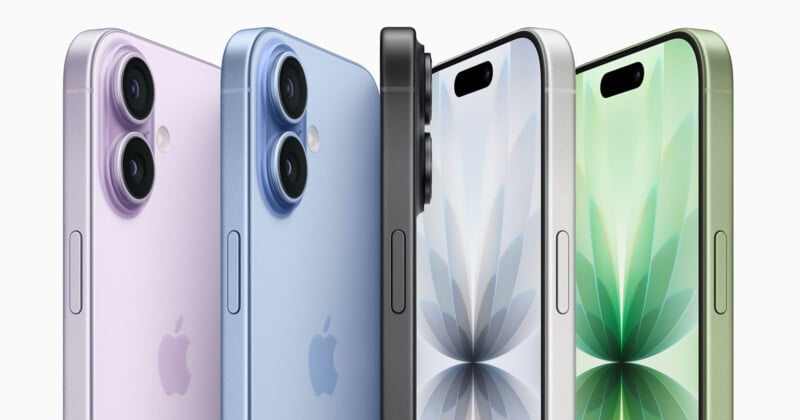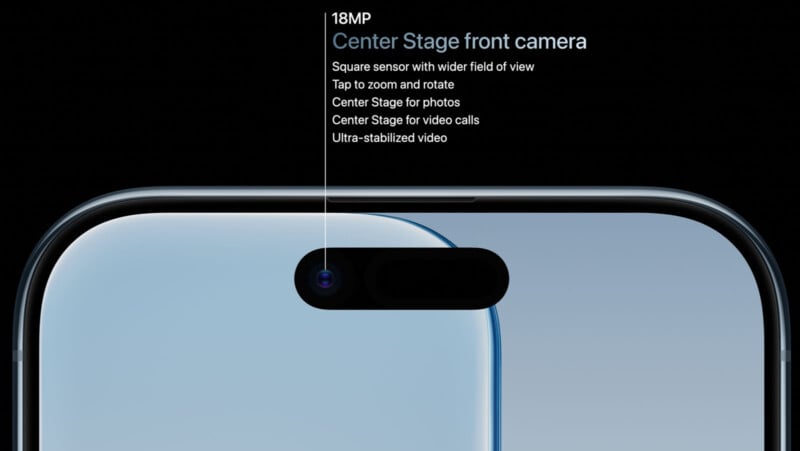Apple iPhone 17 Pro First Impressions: Huge Upgrades for Photo and Video
Apple unveiled its iPhone 17 family today, including the much-improved iPhone 17, the ultra-thin iPhone Air, and the redesigned flagship iPhone 17 Pro and Pro Max. The PetaPixel team flew to Apple Park in Cupertino to witness the unveiling and go hands-on with the new-look iPhone 17 Pro, and there is much to like for photographers and videographers alike.
Redesigned iPhone 17 Pro Sports a Striking New Look for the First Time in Years
The entire iPhone 17 lineup has undergone some major changes, and of course, there’s the new featherweight member of the family, the iPhone Air. But there are some similarities shared between all the phones, perhaps more than in prior years.

All the screens are better across the board, and each iPhone now features ProMotion, which is Apple’s fanciful term for variable refresh rate. Each model this year has a screen that ranges from 1 to 120Hz. Each phone also has 3,000 nits of peak brightness outdoors, which is near the top of the field and will make the iPhone 17 family easier to use outside. They also each have the new Ceramic Shield 2 on the displays to keep them safe. This new protective coating should provide even better scratch resistance than last years models.

New Front-Facing Cameras Across the Board
While the rear cameras across each iPhone model differ, all new iPhone feature a brand-new 24-megapixel front-facing camera. This new “selfie camera” has a couple of interesting tricks up its sleeve.

First, it’s a square sensor. Second, it features Apple’s “Center Stage” technology. Thanks to the additional pixels and the wide-angle lens, the iPhone 17 family’s front camera can automatically reframe as multiple people enter the frame and keep subjects centered. When the frame is at its widest, it will output an 18-megapixel final image, and when zoomed in, it will deliver 12 megapixels.
![]()
While hardcore photographers might not love the front-facing camera, it’s a common tool for content creators, and the iPhone 17’s upgraded, smarter camera will make it even easier to create better content. It can also be used to simultaneously record alongside the rear camera, opening up plenty of reaction video possibilities.
Is the iPhone Air More Than a Pretty Face?
The iPhone Air is gorgeous. Despite its 5.6mm minimum thickness, the Air is made of solid titanium and rugged ceramic construction. It is more durable than any previous iPhone model regardless of design, and should handle the stresses that we subject smartphones to without compromise. It may lack the photo and video chops of its thicker Pro siblings, but its 48-megapixel Fusion main camera takes full advantage of Apple’s hybrid zoom functionality.
At the very least, the iPhone Air may be a popular option for style-conscious iPhone buyers, of whom there are many. However, the Air only features the main rear-facing camera that is shared with the base model iPhone 17. You can go up to a 2X zoom range and still maintain 12 megapixels, but more serious users will find this ultimately limiting.

iPhone 17 Pro and iPhone 17 Pro Max
The addition of the iPhone Air to the lineup also means that Apple is a little less concerned with making its redesigned Pro models super-thin — the iPhone Air serves that audience well enough. Apple’s engineers rebuilt the Pro series from the ground up.

The iPhone 17 Pro and Pro Max feature a slightly thicker aluminum unibody design, an all-new “forged plateau” camera bar, a redesigned vapor chamber for cooling, the new A19 Pro SOC, and a bigger battery. There is no more separate camera housing — it’s all part of a single machined block of aluminum. Much like the new Ceramic Shield 2 on top of the display, the entire iPhone 17 Pro feels more rugged and durable. There’s also ceramic on the back, which is not only tougher than the older glass design, but it has better thermal performance.
Although further testing is required, the new iPhone 17 Pro seeks to fix the main overheating complaint of the iPhone 16 Pro series. Apple claims that the new unibody design has far more capacity to absorb and shed excess heat, and should solve any major overheat issues.
A Brand-New 48-Megapixel Telephoto Camera
The iPhone 17 Pro’s main and ultra-wide cameras are the same, which is not a bad thing. However, the telephoto camera was the weak link on last year’s model, and thankfully, that’s been replaced with a larger new 48-megapixel sensor. It boasts a 56% larger sensor than the older, smaller 12MP telephoto camera from last year.
![]()
![]()
We’re excited to test the iPhone 17 Pro’s new telephoto camera out in the real world. It should, thankfully, deliver a step-up from last year’s telephoto camera.
Of course, with all of Apple’s marketing surrounding its Fusion cameras and zooming, it is worth, yet again, pointing out that there is a lot of fancy cropping technology involved here when swapping focal lengths — like from 24mm to 28mm to 35mm to 50mm. In fact, there is a new 8x lens mode delivering a 200mm full-frame equivalent field of view. However, this reduces the resolution down to 12 megapixels.
Not every selected focal length shoots at 48 megapixels, and even when they do, it’s with Quad Bayer technology. The iPhone 17 Pro’s 48 megapixels won’t deliver the same image quality as the full-frame Sony a1 II’s 50-megapixel sensor, for example.
![]()
The iPhone 17 Pro’s Video Features Are Exciting
The iPhone 16 Pro and Pro Max introduced a lot of compelling video features last year, including 4Kp120 on the main camera (which is still the case this year), ProRes Log recording, and spatial audio recording.
Now, this year, the iPhone 17 Pro and Pro Max get ProRes RAW recording, at least when recording externally. This tried-and-true RAW video format offers considerable flexibility during post-production, and is more versatile than the existing ProRes 422 HQ already available on iPhone.
![]()
Surprisingly, during Apple’s keynote, the company didn’t mention that the iPhone 17 Pro can record Open Gate in ProRes RAW, which enables videographers to utilize the entire 4:3 image sensor and reframe their videos after the fact. This is a great feature, even though the video files will be beefy.
With that caveat aside, it’s also worth noting that the iPhone 17 Pro Max model comes in a 2TB version this year, although it’ll cost you $1,999, $800 more than the base 256GB model.
Lots to Like and Even More to Test
There are many changes on offer in the iPhone 17 lineup this year, much more than in a typical year. Apple promised to significantly shake things up when it started its keynote today, and the company delivered. There is a lot for us to test in our full review, but we are as excited to put the new iPhone 17 Pro through its paces as ever.